Abstract
To evaluate the impact cirrhosis has on survival the records of 40 cirrhotic trauma victims from the registries of two Level 1 trauma centers were reviewed and probability of survival calculated using the TRISS methodology. Mechanism of injury, anatomic location, involvement of single or multiple sites, presence of ascites, elevations in serum glutamic oxaloacetic transaminase (SGOT), alkaline phosphatase, serum bilirubin, prothrombin time (PT), and hypoalbuminemia were tabulated for each patient. Contingency tables were created for injury and hepatic parameters, as related to survival, and subjected to chi square analysis. Loglinear analysis was performed on all significant parameters to evaluate the independent effects of injury characteristics and hepatic insufficiency on survival. Predicted survival was 93%; observed survival was 70% (Z = -6.92; p less than 0.001). Cause of death was multiple-system organ failure (9) and closed head injury (3). Admission markers of poor outcome included one or more of the following: ascites, elevated PT or bilirubin, history of motor vehicle accident, multiple trauma, or blunt abdominal trauma requiring laparotomy. Loglinear analysis revealed that the presence of ascites, elevated PT, or bilirubin, further diminished the rate of survival for any individual injury characteristic. We concluded that survival among cirrhotic trauma victims was significantly lower than predicted. In addition the presence of hepatic insufficiency further diminishes survival, regardless of the injury sustained.
Full text
PDF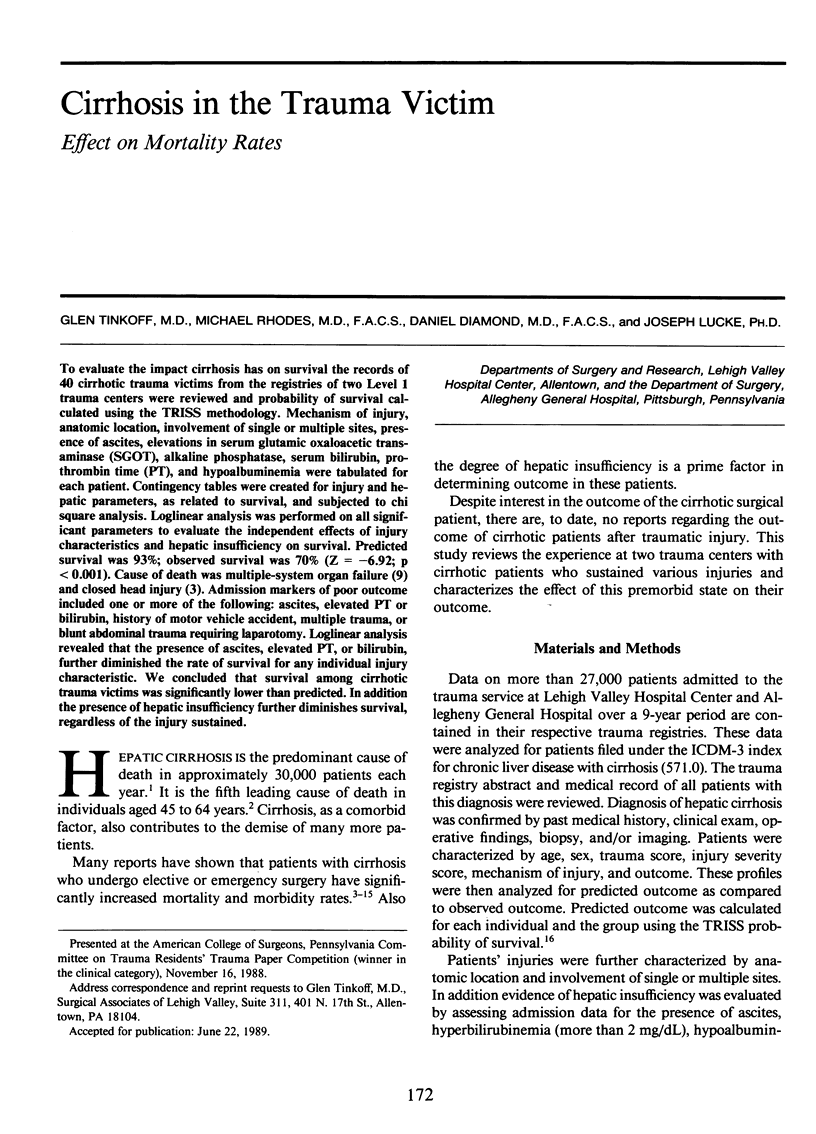
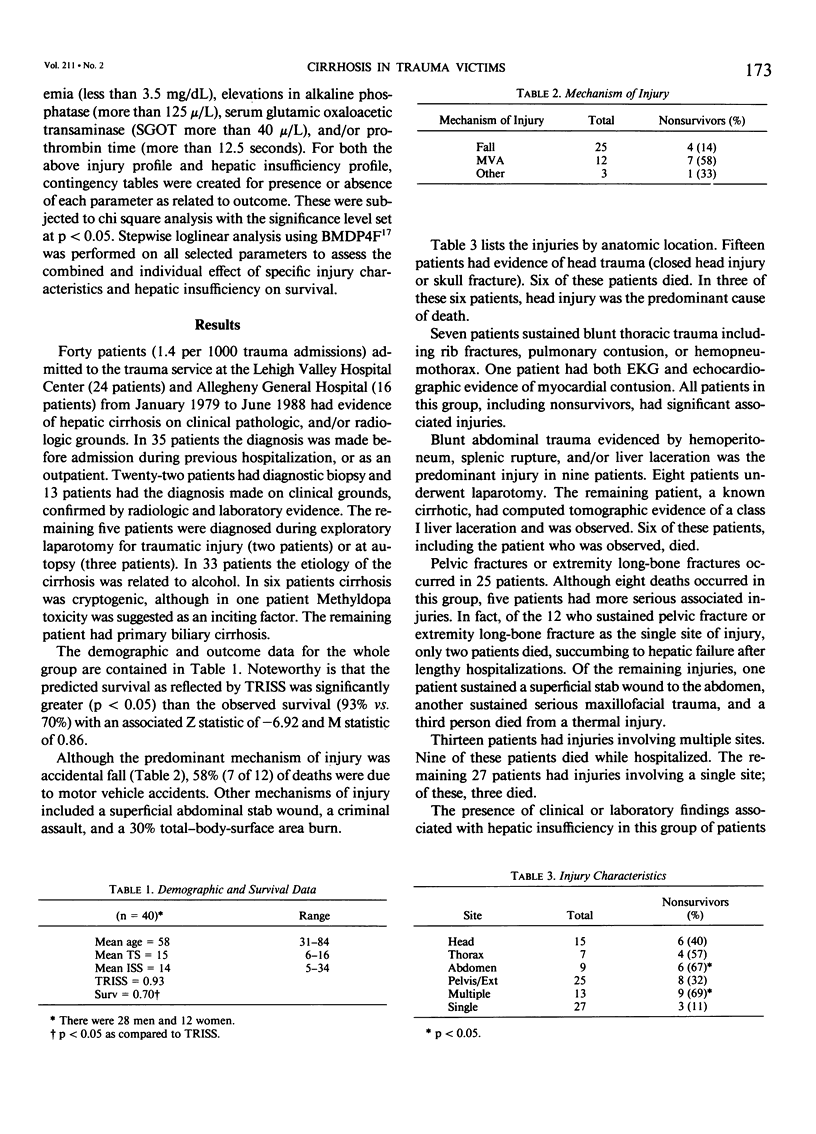
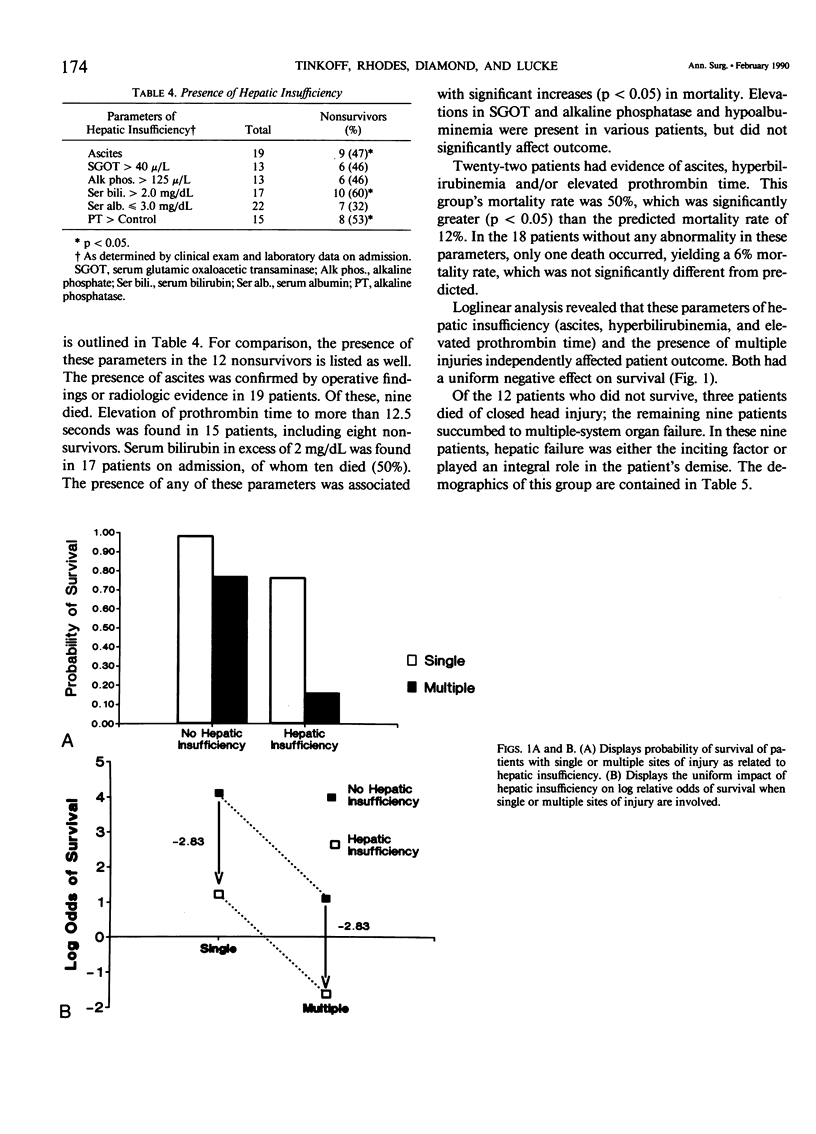
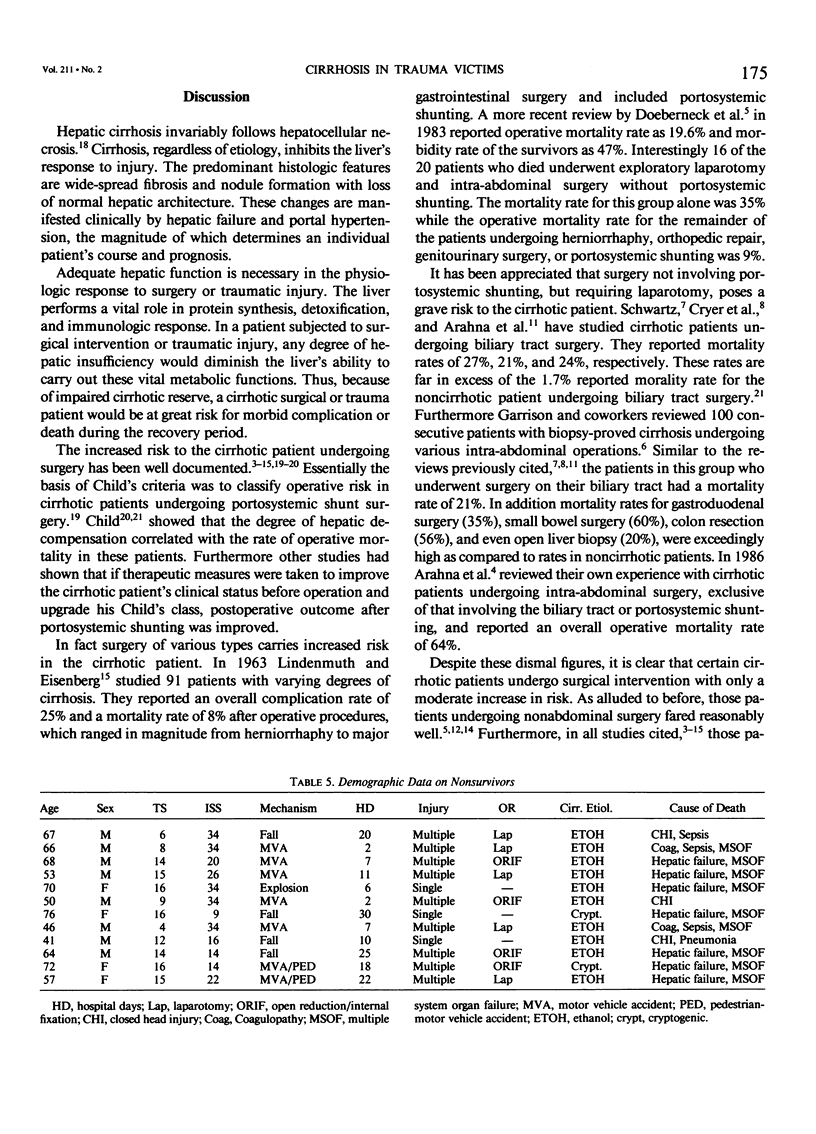
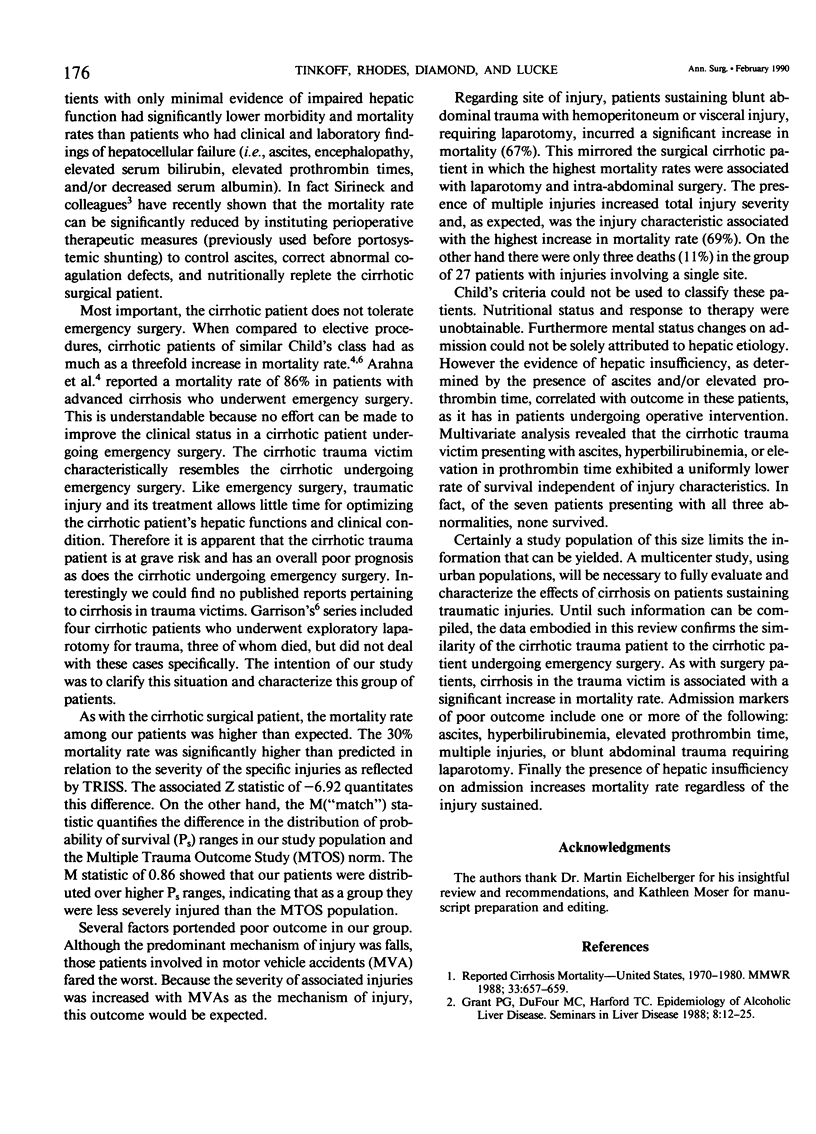
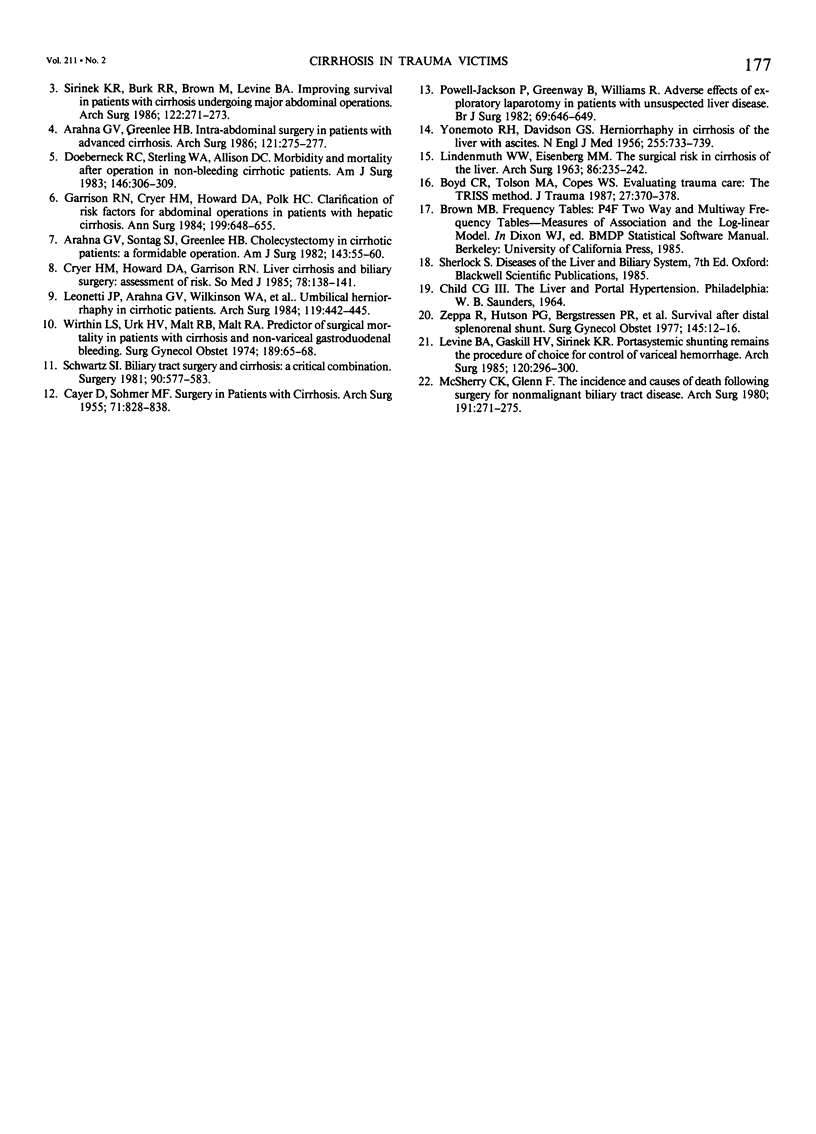
Selected References
These references are in PubMed. This may not be the complete list of references from this article.
- Aranha G. V., Greenlee H. B. Intra-abdominal surgery in patients with advanced cirrhosis. Arch Surg. 1986 Mar;121(3):275–277. doi: 10.1001/archsurg.1986.01400030029003. [DOI] [PubMed] [Google Scholar]
- Aranha G. V., Sontag S. J., Greenlee H. B. Cholecystectomy in cirrhotic patients: a formidable operation. Am J Surg. 1982 Jan;143(1):55–60. doi: 10.1016/0002-9610(82)90129-5. [DOI] [PubMed] [Google Scholar]
- Boyd C. R., Tolson M. A., Copes W. S. Evaluating trauma care: the TRISS method. Trauma Score and the Injury Severity Score. J Trauma. 1987 Apr;27(4):370–378. [PubMed] [Google Scholar]
- CAYER D., SOHMER M. F. Surgery in patients with cirrhosis. AMA Arch Surg. 1955 Dec;71(6):828–838. doi: 10.1001/archsurg.1955.01270180034005. [DOI] [PubMed] [Google Scholar]
- Cooper G., Bell G. Combined antrectomy and Roux-en-Y anastomosis in the surgical treatment of recurrent peptic ulceration. Br J Surg. 1982 Nov;69(11):646–650. doi: 10.1002/bjs.1800691106. [DOI] [PubMed] [Google Scholar]
- Cryer H. M., Howard D. A., Garrison R. N. Liver cirrhosis and biliary surgery: assessment of risk. South Med J. 1985 Feb;78(2):138–141. doi: 10.1097/00007611-198502000-00005. [DOI] [PubMed] [Google Scholar]
- DAVIDSON C. S., YONEMOTO R. H. Herniorrhaphy in cirrhosis of the liver with ascites. N Engl J Med. 1956 Oct 18;255(16):733–739. doi: 10.1056/NEJM195610182551601. [DOI] [PubMed] [Google Scholar]
- Doberneck R. C., Sterling W. A., Jr, Allison D. C. Morbidity and mortality after operation in nonbleeding cirrhotic patients. Am J Surg. 1983 Sep;146(3):306–309. doi: 10.1016/0002-9610(83)90402-6. [DOI] [PubMed] [Google Scholar]
- Garrison R. N., Cryer H. M., Howard D. A., Polk H. C., Jr Clarification of risk factors for abdominal operations in patients with hepatic cirrhosis. Ann Surg. 1984 Jun;199(6):648–655. doi: 10.1097/00000658-198406000-00003. [DOI] [PMC free article] [PubMed] [Google Scholar]
- Grant B. F., Dufour M. C., Harford T. C. Epidemiology of alcoholic liver disease. Semin Liver Dis. 1988 Feb;8(1):12–25. doi: 10.1055/s-2008-1040525. [DOI] [PubMed] [Google Scholar]
- LINDENMUTH W. W., EISENBERG M. M. The surgical risk in cirrhosis of the liver. Arch Surg. 1963 Feb;86:235–242. doi: 10.1001/archsurg.1963.01310080059014. [DOI] [PubMed] [Google Scholar]
- Leonetti J. P., Aranha G. V., Wilkinson W. A., Stanley M., Greenlee H. B. Umbilical herniorrhaphy in cirrhotic patients. Arch Surg. 1984 Apr;119(4):442–445. doi: 10.1001/archsurg.1984.01390160072014. [DOI] [PubMed] [Google Scholar]
- Levine B. A., Gaskill H. V., 3rd, Sirinek K. R. Portasystemic shunting remains the procedure of choice for control of variceal hemorrhage. Arch Surg. 1985 Mar;120(3):296–300. doi: 10.1001/archsurg.1985.01390270036007. [DOI] [PubMed] [Google Scholar]
- McSherry C. K., Glenn F. The incidence and causes of death following surgery for nonmalignant biliary tract disease. Ann Surg. 1980 Mar;191(3):271–275. doi: 10.1097/00000658-198003000-00003. [DOI] [PMC free article] [PubMed] [Google Scholar]
- Schwartz S. I. Biliary tract surgery and cirrhosis: a critical combination. Surgery. 1981 Oct;90(4):577–583. [PubMed] [Google Scholar]
- Sirinek K. R., Burk R. R., Brown M., Levine B. A. Improving survival in patients with cirrhosis undergoing major abdominal operations. Arch Surg. 1987 Mar;122(3):271–273. doi: 10.1001/archsurg.1987.01400150025003. [DOI] [PubMed] [Google Scholar]
- Wirthlin L. S., Van Urk H., Malt R. B., Malt R. A. Predictors of surgical mortality in patients with cirrhosis and nonvariceal gastroduodenal bleeding. Surg Gynecol Obstet. 1974 Jul;139(1):65–68. [PubMed] [Google Scholar]
- Zeppa R., Hutson D. G., Sr, Bergstresser P. R., Levi J. U., Schiff E. R., Fink P. Survival after distal splenorenal shunt. Surg Gynecol Obstet. 1977 Jul;145(1):12–16. [PubMed] [Google Scholar]


